open 10 am - 7 pm
laboratory is closed
SSEF

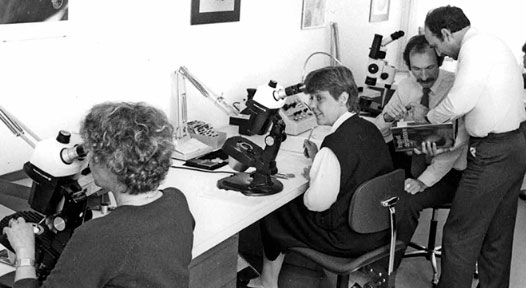
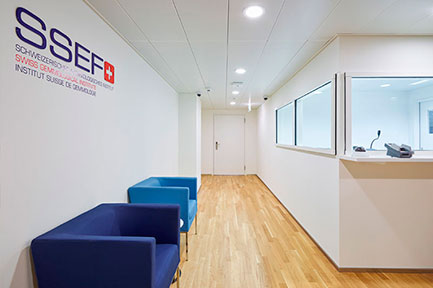
The Swiss Foundation for Gemstones Research (Schweizerische Stiftung für Edelstein-Forschung, SSEF) carries out expert and educational activities as one of its divisions - the Swiss Gemological Institute (Swiss Gemmological Institute, SGI), located in Basel (Basel), Switzerland.
The Swiss Gem Research Foundation was founded in 1974 with the support of the Union of Swiss Jewelers and Jewelry Traders (UBOS: Union de la Bijouterie et Orfèvrerie Suisse).
Since its inception, SSEF has been studying the physicochemical and mineralogical properties of diamonds and other gemstones, developing equipment for identifying jewelry materials and determining the presence of a particular treatment in order to change their properties.
Since 1978, the SSEF has been recognized by the CIBJO International Confederation (International Confederation of Jewelery, Silverware, Diamonds, Pearls and Stones) and is the custodian of the original CIBJO Diamond Master Set, C1.
In 2001, an education department was created that offers course programs in gemology.
SSEF is also a member of the International Colored Gemstone Association (ICA) and the Laboratory Manual Harmonization Committee (LMHC) of the International Colored Gemstone Association (ICA).
SSEF gemological reports
Gemological reports issued by the SSEF certification laboratory are recognized as one of the most authoritative gemmological reports in Europe. Traditionally, SSEF reports are divided into three categories:
- Reports on single individual diamonds of not fancy color;
- Reports on single individual gems, including fancy colored diamonds;
- Test report issued on stones in jewelry, as well as on a batch of jewelry stones.
Appearance of gemological reports, SSEF unified for each type.
All gemological reports on single individual gems have the following information blocks:
- Logo of the Swiss Gemological Institute (SGI SSEF)
- Full-color image of the stone (indicating the increase)
- Unique number
- Carat stone weight (up to thousandths of a carat)
- The shape of the cut, determined by the girdle contour, and the type of cut
- Stone's linear dimensions (up to hundredths of a millimeter)
- Color (in the description of the spectral tint)
- Trade color terminology (for top quality colors)
- Determination of the mineral species (variety), its origin (synthetic, natural - by default), as well as in the presence of refining - the fact of refining
- Comments: indicates the absence or presence of refinement, as well as the type of refining and its degree. For a number of jewelry stones, expert opinion on the geographic region of stone mining is indicated
- Additional terms (important information)
- Links to lab email
- Location of the laboratory - Basel (Basel), Date, in the format - a number (numeric characters), month (alphabetic characters), year (numeric characters)
- Signature of an expert and laboratory director
Gemological calibration reports for single individual diamonds of not fancy colors have the following information blocks:
- Logo of the Swiss Gemological Institute (SGI SSEF)
- Unique number
- Grading by category "4C":
- Carat diamond weight (up to thousandths of a carat)
- Diamond color (in accordance with ISO / TR-11211 nomenclature)
- Clarity diamond (in accordance with ISO / TR-11211 nomenclature)
- General grade of cut (in accordance with ISO / TR-11211 nomenclature)
- Other features:
- The shape of the cut, determined by the girdle contour, and the type of cut
- Stone's linear dimensions (up to hundredths of a millimeter)
- Grading of symmetry cut (in accordance with the ISO / TR-11211 nomenclature)
- Grading of polishing cut (in accordance with ISO / TR-11211 nomenclature)
- Proportions (relative size of the site and the height of the diamond in %)
- Girdle description (in accordance with ISO / TR-11211 terms)
- Grading of fluorescence (in accordance with ISO / TR-11211 nomenclature)
- Comments: the determinants of clarity, graining, extrafacets and nayfs are indicated; the fact of the absence or presence of refining, as well as the type of refining. Diamonds that are treated in the form of filling cavities and cracks (in accordance with the rules of CIBJO) are not classified by quality.
- Plotting (Defect Diagram)
- Additional terms (important information)
- Links to lab email
- Location of the laboratory - Basel (Basel), Date, in the format - a number (numeric characters), month (alphabetic characters), year (numeric characters)
- Signature of an expert and laboratory director
In addition, SSEF produces reports for premium-grade stones with a cover letter and an enhanced quality photo image (PREMIUM REPORTS).
Examples of the design of the reports of the Swiss Gemological Institute "SGI SSEF":
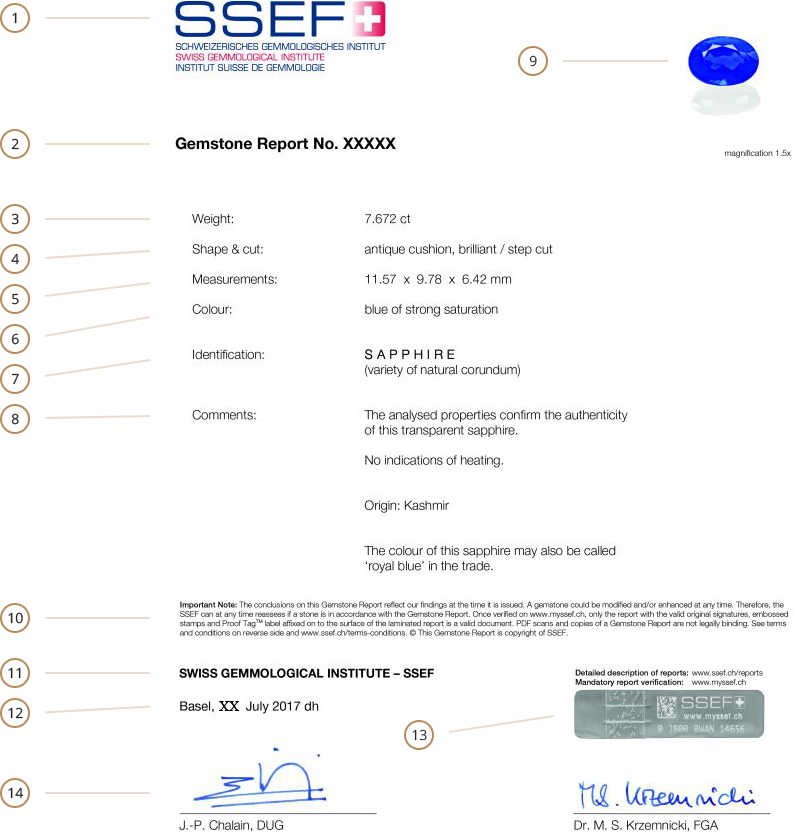
«Anatomy» of a gemological report «Gemstone Report» for natural sapphire:
- Company`s logo
- Unique report number
- Carat weight
- Shape and type of cut ((in the case of a mixed – cut for the crown / for the pavilion)
- Linear dimensions in millimeters
- Color (basic spectral tint, if necessary, specifying lightness and saturation factors)
- Mineral variety (with clarification of the name of the mineral species)
- Comments: on the conformity of the properties of the subject matter of the examination to the mineral species, on the presence or absence of refining, expert opinion on the mining region, trade terminology for the quality characteristics of the stone
- Full-color image of the object of examination
- Notes (important information)
- Name of expert organization
- Lab Location and Date
- Links to electronic resources of the organization
- Signatures of the expert and the director of the laboratory
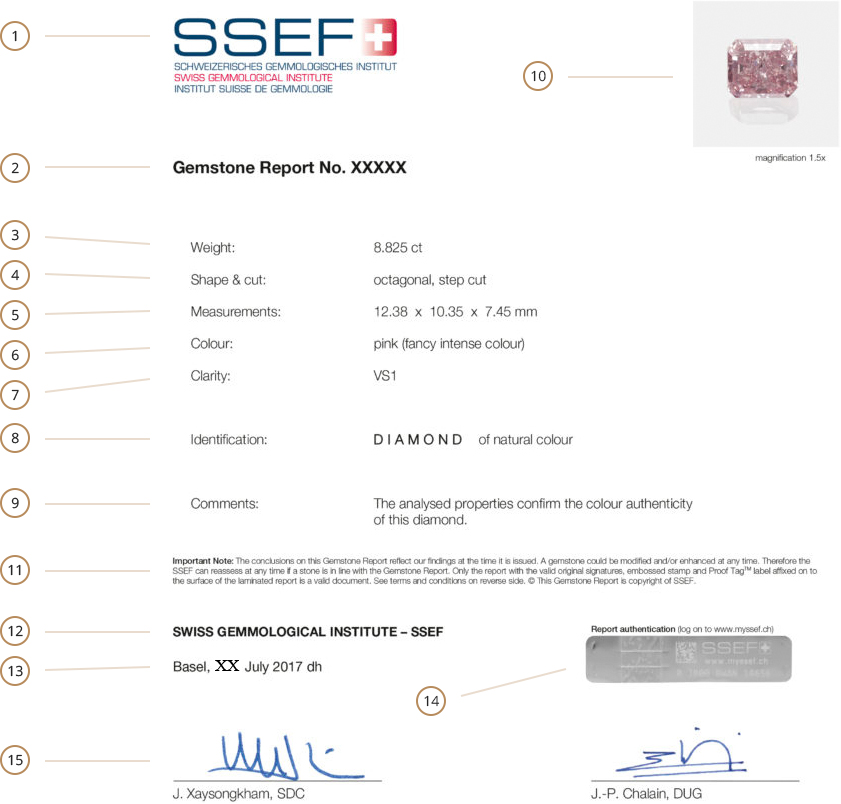
«Anatomy» of a gemological report «Gemstone Report» for natural fancy colored diamond:
- Company`s logo
- Unique report number
- Carat weight
- Shape and type of cut
- Linear dimensions in millimeters
- Qualitative color characteristic (main spectral tint with refinement of the fantasy color)
- Qualitative characteristic of clarity (in accordance with ISO / TR-11211)
- Mineral variety (with clarification of the nature of color)
- Comments: on the conformity of the properties of the subject matter of the examination to the mineral species
- Full-color image of the object of examination
- Notes (important information)
- Name of expert organization
- Lab Location and Date
- Links to electronic resources of the organization
- Signatures of the expert and the director of the laboratory
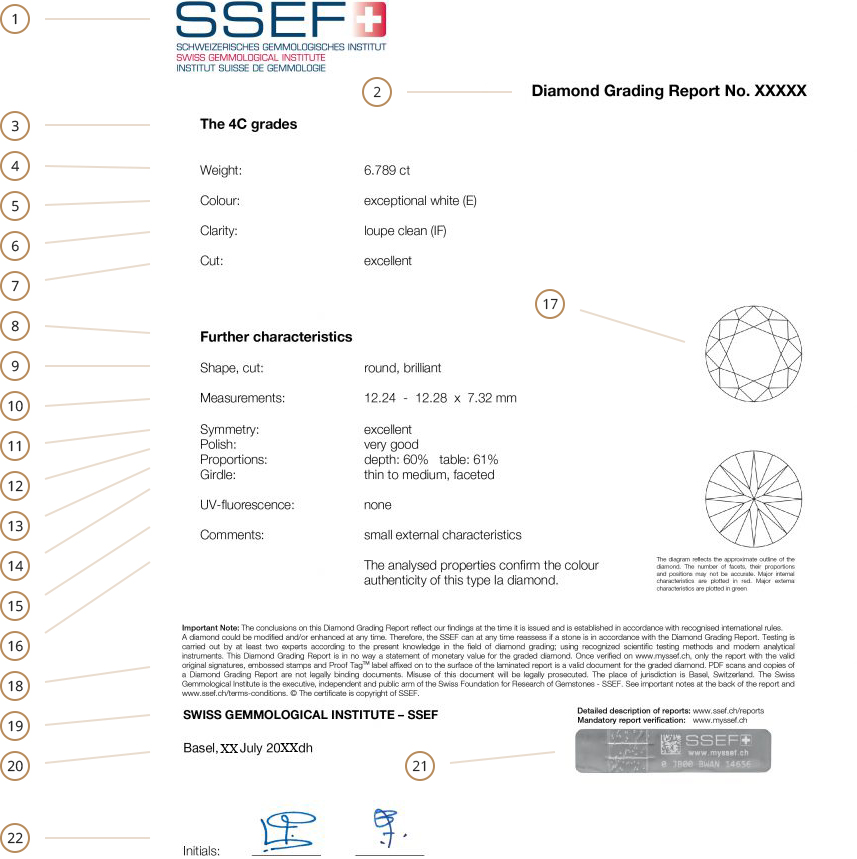
«Anatomy» of a gemological report «Diamond Grading Report» for ordinary natural diamond:
- Company`s logo
- Unique report number
- Grading of the main quality characteristics «4С» (4-7)
- Carat weight
- Color (according to ISO / TR-11211 nomenclature)
- Clarity (in accordance with ISO / TR-11211 nomenclature)
- Cut quality (in accordance with ISO / TR-11211 nomenclature)
- Additional grading characteristics (9-15)
- Shape and type of cut
- Linear dimensions in millimeters
- Grading of symmetry (in accordance with ISO / TR-11211 nomenclature)
- Polishing grading (in accordance with ISO / TR-11211 nomenclature)
- Proportions (relative size of total height and crown)
- The thickness and type of girdle (in accordance with ISO / TR-11211 nomenclature)
- Ultraviolet luminescence parameters (in accordance with ISO / TR-11211 nomenclature)
- Comments (determination of the characteristics of clarity and physico-chemical type of diamond)
- Plotting
- Notes (important information)
- Name of expert organization
- Lab Location and Date
- Links to electronic resources of the organization
- Signatures of the expert and the director of the laboratory
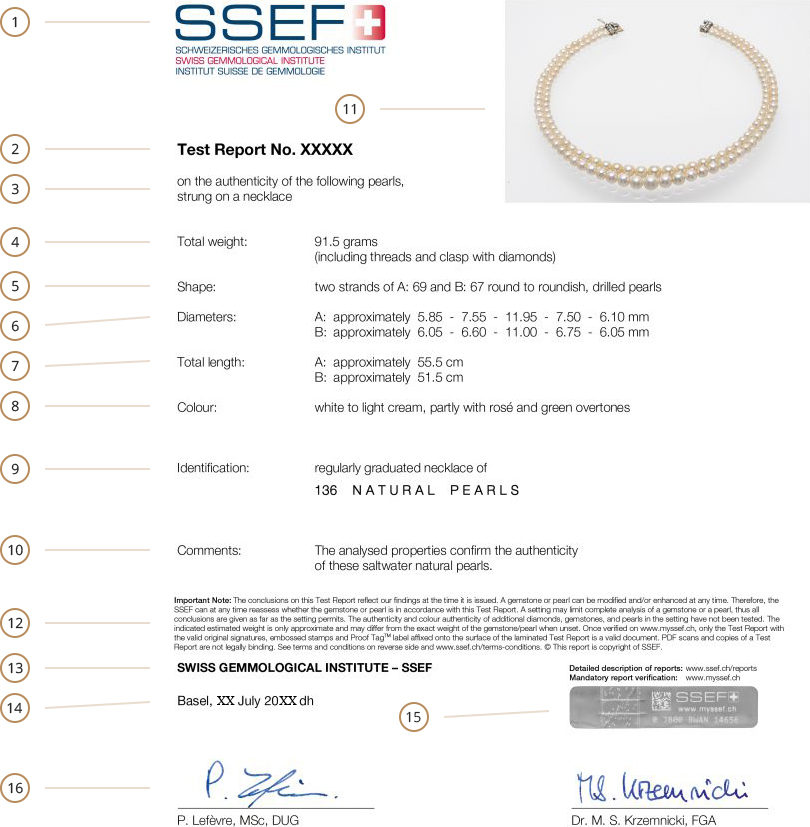
«Anatomy» of a gemological report (test report) «Test Report» for jewelry with jewels (pearls):
- Company`s logo
- Unique report number
- Description of the object of examination
- Total Weight (grams)
- Shape
- Linear dimensions of inserts
- Linear dimensions of elements
- Color
- Result of examination and identification
- Comments: conditions and environment of pearl growth
- Full-color image of the object of examination
- Notes (important information)
- Name of expert organization
- Lab Location and Date
- Links to electronic resources of the organization
- Signatures of the expert and the director of the laboratory

